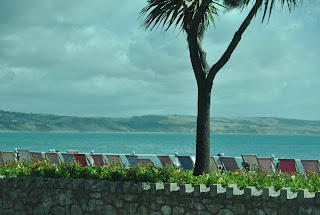Our last day still dawned a little on the overcast and cool
side, although we had been promised better weather as the day progressed. Good
thing, as we were only visiting until 2:00 in the afternoon!
 |
| Low tide. There are some huge tidal differences in Jersey, ranking just behind the Bay of Fundy and Seattle |
Our chosen shore excursion was to a winery, only because it
seemed so strange that anyone would be able to produce wine on an English island
off the coast of France. The ship's head sommelier, Tilmar, was also very
curious as he was our tour escort.
Not only did we have a winery tour, but our bus driver and
guide took us around about half of the island before dropping us back at the
port for our tender.
For some reason, we didn't think that Jersey is as big an
island as it turned out to be. It might be that the islands we saw from
Guernsey on our last trip were the very much smaller ones of Herm and Sark. The
trip to the winery took about 1/2 hour and wound up to the heights, through
some very picturesque villages outside of St. Helier.
 |
| Jersey cattle. That breed made famous by a chocolate bar originates here on the island |
The La Mare Winery and Distillery is the only winery on the
island. It is owned by a former wine merchant from London who decided, once he
had moved to Jersey, to plant a few vines of the appropriate types of grapes
and make a bit of wine. Now the winery has about 6 acres planted of 4
varieties, and their wines are a blend of various of them. Monica tasted a
white similar to sauvignon blanc, another sweeter variety and then a red blend
that was actually quite nice. Maybe that was because it was served with
chocolate!
 |
| Apple trees from which they make their cider |
 |
| The growing season is a bit different on Jersey because of the climate. Harvest time is October to November rather than September |
Not only do they make wine, sparkling wine and apple cider,
but the winery has a chocolatier on staff who had been challenged to go to
France and create a chocolate blend that would go well with their red wine. They
sell that chocolate, a few other flavours, and fudge made with cream from the
local herd of Jersey cows.
 |
| A still that is used to make brandy at La Mare |
 |
| Love that sign! This is the chocolatier's workspace |
The owner's house is beautiful and the gardens around the
winery are gorgeous. The hydrangeas were blooming profusely and in beautiful
shades of purple and blue.
Once we left the winery, we had a bit of a whirlwind tour of
the west end of the island. The winery is actually on the north side of the
island, almost straight across from St. Helier. Since we made no stops, we
don't have lots of detail on what we saw (we couldn't remember everything the
guide told us, he crammed so much into the drive). We did learn that Jersey is
a protectorate of Britain. The islanders make most of their own laws, and
rather than having representatives at Parliament, they are answerable to the
Crown instead.
Jersey was the only British territory that the Germans
occupied during World War II, and they spent quite a lot of money on
fortifications. Nowadays various of these buildings have been put to some
rather ingenious uses - what used to be a watchtower can now be rented for a
vacation home, and an old bunker by the sea has been turned into a
fishmonger/restaurant:
 |
| Faulkner Fisheries out on that short spit of land |
 |
| One of the many beaches |
 |
| Les Mielles Nature Reserve |
 |
| The La Moye Golf Course. One of the European Tour Championship stops is on Jersey |
 |
| La Corbiere Lighthouse. You can see that there seems to be no way to get there...that's because the road is under water at high tide. Hard to see here, but it's still there. |
 |
| Some houses around the town of St. Aubin, near St. Helier |
Yet another unexpected surprise at a new destination! The
whole southern part of England needs some more in-depth exploration.
The only cloud over the morning was the long lineup for
tenders to go back to the ship. This is practically unheard-of with Crystal, so there had to be
another explanation. The port is rather busy with ferries, cargo ships and
pleasure craft all coming in and out through a fairly narrow opening in the breakwall. Every
time a larger vessel moves around, everything else has to stop, and of course
there were two cargo ships and a large passenger ferry holding up all the other
traffic just while we waited. There were lots of grumbles from the line around
us until they saw that 3 of our 5 tenders were all coming in one behind the
other to pick us up. We did end up leaving a bit late but we still arrived in
Dover for our 3:00 A.M. docking.
The end of another wonderful cruise with Crystal. We renewed
a lot of acquaintances with the staff - one of whom, Anthony, still remembered
us from Harmony!! - and made some new friends among the guests. We hope to keep
in touch and perhaps see them again on our next cruise.




















































